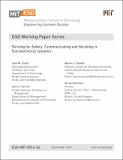| dc.contributor.author | Flach, John M. | |
| dc.contributor.author | Carroll, John Stephen | |
| dc.contributor.author | Dainoff, Marvin J. | |
| dc.contributor.author | Hamilton, W. Ian | |
| dc.date.accessioned | 2016-06-06T23:16:34Z | |
| dc.date.available | 2016-06-06T23:16:34Z | |
| dc.date.issued | 2014-09 | |
| dc.identifier.uri | http://hdl.handle.net/1721.1/103019 | |
| dc.description.abstract | How do communications and decisions impact the safety of sociotechnical systems? This paper frames this question in the context of a dynamic system of nested sub-systems. Communications are related to the construct of observability (i.e., how components integrate information to assess the state with respect to local and global constraints). Decisions are related to the construct of controllability (i.e., how component sub-systems act to meet local and global safety goals). The safety dynamics of sociotechnical systems are evaluated as a function of the coupling between observability and controllability across multiple closed-loop components. Two very different domains (nuclear power and the limited service food industry) provide examples to illustrate how this framework might be applied. While the dynamical systems framework does not offer simple prescriptions for achieving safety, it does provide guides for exploring specific systems to consider the potential fit between organisational structures and work demands, and for generalizing across different systems regarding how safety can be managed. | en_US |
| dc.language.iso | en_US | en_US |
| dc.publisher | Massachusetts Institute of Technology. Engineering Systems Division | en_US |
| dc.relation.ispartofseries | ESD Working Papers;ESD-WP-2014-26 | |
| dc.title | Striving for Safety: Communicating and Deciding in Sociotechnical Systems | en_US |
| dc.type | Working Paper | en_US |
